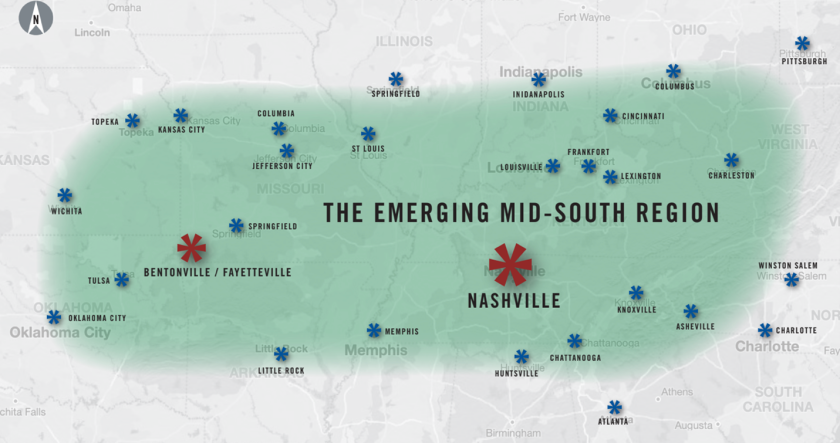Trying to think about geography in new ways can sometimes provide new insights and new ways of thinking about economic opportunity. One such thought experiment was created by my friend, the branding consultant Carl Wohlt. He proposed a conceptual region he called the “Mid-South” (a term already in use in various other contexts, such as for the Memphis area, but used in a new way here.) This Mid-South contains sections of the northern part of the South and the southern part of the Midwest. Nashville is the capital of this region, and the Bentonville/Northwest Arkansas area its western hub.

Consider Kentucky. It is usually considered a southern state. But it was never part of the Confederacy. And Louisville is a huge manufacturing city — think Ford, GE and DuPont — with strong unions. Southern Illinois and Indiana, also part of the mid-South, are much different from the stereotypes of their states. Rather than flat expanses of prairie and corn, there are rolling hills and trees. The culture is southern-inflected. Tennessee and Arkansas are more truly southern, but still clearly different from Mississippi, Alabama or Georgia.
Apart from Nashville, Walmart-dominated Bentonville and a few other places, population growth and economic success in the Mid-South have been defined more by cities on its periphery than by the interior. Most of the region lacks high-powered academic institutions vital to the 21st-century knowledge economy.
Partly for that reason, the area tends to be overlooked, operating in the shadows of the other regions with which various pieces of it are usually associated. But the amenities that the mid-South offers can be a big draw if the brand perception changes. Nashville is the best example of that, changing from an overgrown backwater to a national hot destination in a relatively short period of time.
This shows the potential value of the Mid-South starting to think of itself and market itself as a region, instead of simply as part of the Midwest or the South. This would allow it to put its best foot forward and let people know about real amenities that might otherwise be lost in the public’s mind.
For example, with cities throughout the West being bought up by coastal refugees at a fearsome rate, the prices of property there are skyrocketing out of reach. By contrast, the Mid-South has some of the last physically beautiful land in the country that’s still affordable and not burdened with extreme seasonal weather. It’s still possible to buy land here for a reasonable price, and many towns and cities remain to be discovered.
A new narrative for this region, one that gives it a coherent reputation and image, would help lure new residents and drive new investment, something large parts of the region badly need.
This isn’t to say that simply creating a new map will conjure up new residents and economic development. But for areas whose best assets are not properly captured under the existing regional frameworks, repositioning themselves in a new regional construct is a viable solution. That applies to other American regions besides the Mid-South.
The idea could work at smaller scales. The cities and towns along the Ohio River might be able to create a regional identity among themselves. There are many similarities between Louisville, Cincinnati and Pittsburgh (and St. Louis, though it is on the Mississippi a bit above the confluence with the Ohio). The trick is to leverage them.
Trying to reconceptualize is not necessarily a fit for every place, but for those areas whose existing regional definitions and narratives don’t fairly capture their assets or essence, it’s a strategy to look at. There’s no reason to accept regional definitions as unchangeable givens.
Governing opinion columns reflect the views of their authors and not necessarily those of Governing’s editors or management.












